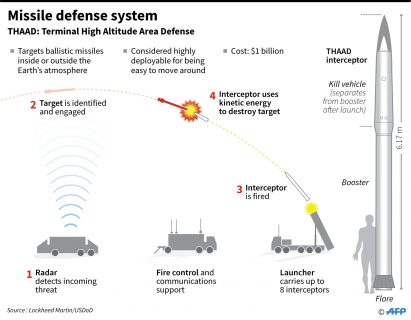
Washington has already deployed a powerful anti-missile system, THAAD (Terminal High Altitude Area Defense), in the Asia-Pacific region, including South Korea, Japan and Guam itself.
The system uses “hit-to-kill” technology, and it was successfully tested against an IRBM for the first time last month in Alaska.
But it is designed to intercept a missile at the final “terminal” stage of its flight, so the South Korean- and Japanese-based batteries are unlikely to be effective.
And the Guam-based systems could also struggle to handle four incoming devices simultaneously, analysts say.
“THAAD might have a shot. But four targets at once would be fun,” tweeted Jeffrey Lewis of the California-based Middlebury Institute of International Studies.
“I’d add an Aegis or two,” he said, referring to the US naval weapons system designed to track and destroy guided weapons, which includes SM-3 missiles within its arsenal.
THAAD is an American anti-ballistic missile defense system designed to shoot down short, medium, and intermediate range ballistic missiles in their terminal phase, including descent or reentry, by intercepting with a hit-to-kill approach.
The THAAD interceptor carries no warhead.
It relies on its kinetic energy of impact to destroy the incoming missile.
This kinetic energy hit minimizes the risk of exploding conventional warhead ballistic missiles. It is believed that nuclear tipped ballistic missiles will not detonate upon a kinetic energy hit. (with AFP report)
